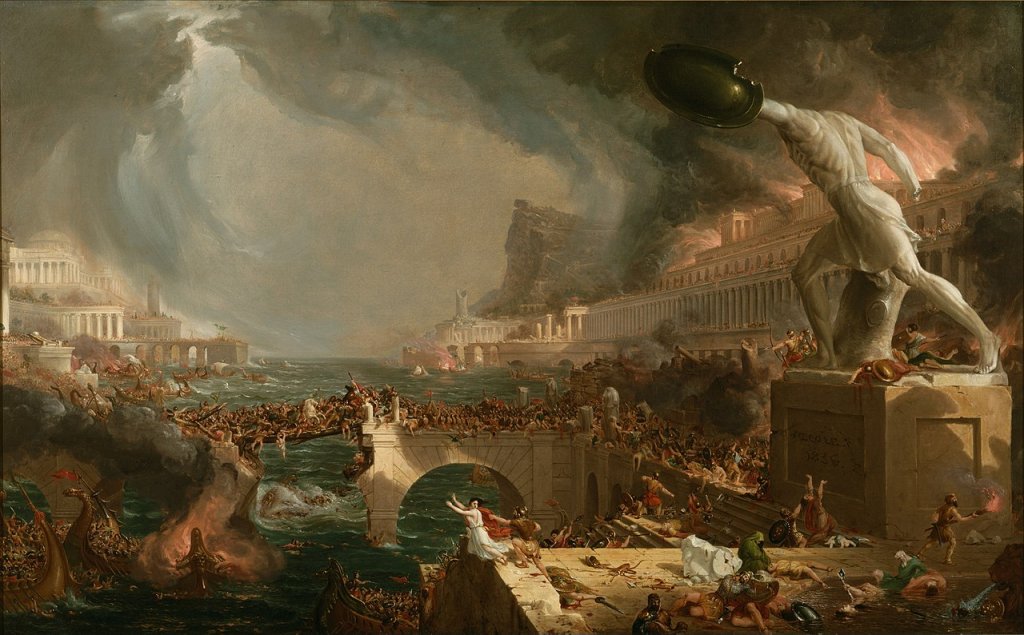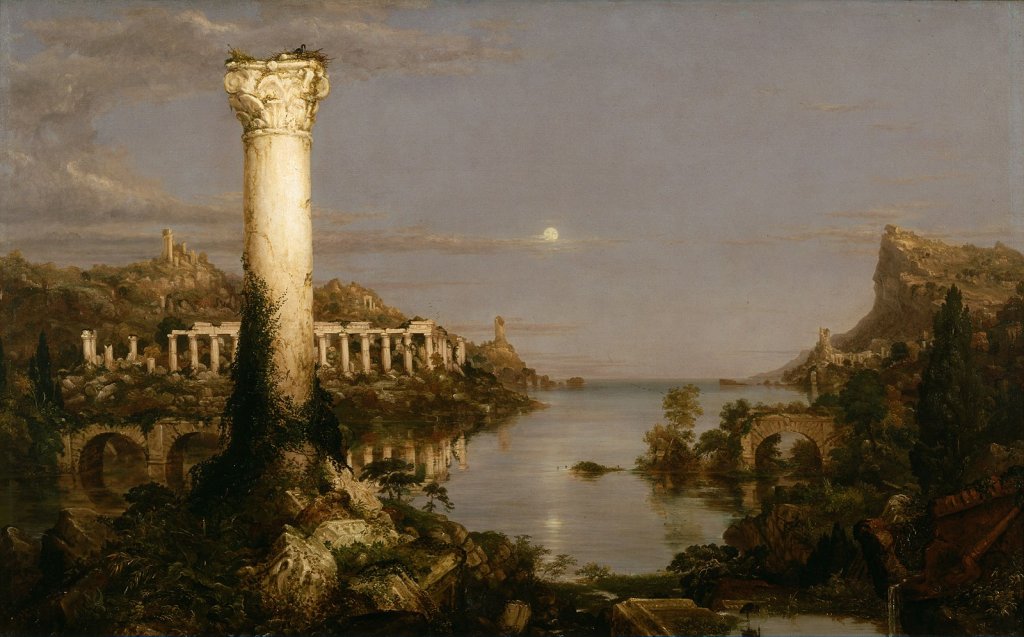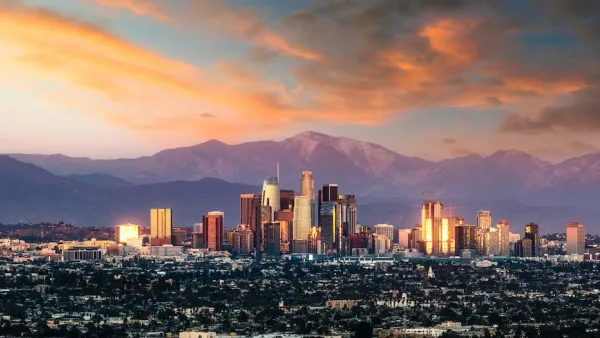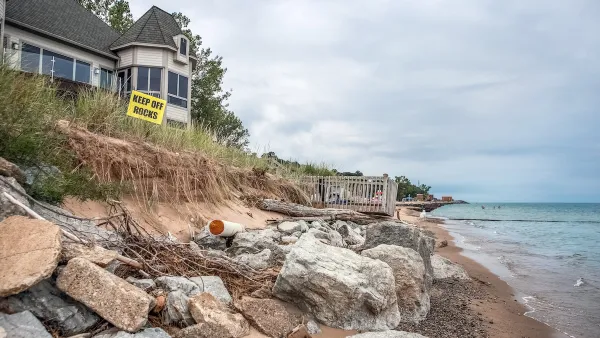A series of 19th century paintings that illustrates the rise and fall of empire highlights the limits of growth.

On Earth Day, the New York Historical Society featured Thomas Cole’s The Course of Empire on their social media. The work is featured as part of their exhibition Nature, Crisis, Consequence, available for viewing from March 31st, 2023 to July 16th, 2023. The exhibition, “looks at the social and cultural impact of the environmental crisis on different communities across America” and includes The Course of Empire as a featured exhibition to convey Cole’s “urgent warning against uncontrolled expansion into the natural world.”
I had seen this series of landscape paintings before in college when I took a year-long course in Art History. Cole was a member of the Hudson School, a collection of artists who became known for their landscape paintings of the Hudson Valley, the area of the school I attended, Vassar College. I think the painting stuck with me because of this, but it’s certainly difficult to forget the detailed atmosphere and landscape scenes that Cole captures in The Course of Empire.
In this series, Cole explores the rise and fall of an “empire” through a series of five paintings that depict the formation and ruin of a city or an “empire.” The series of landscape paintings contain myriad details that show the interconnectedness of colonization, social stratification, architecture, and city planning. I think for many who look at this series, the message is clear, but what many might not gravitate towards thinking about is: urban planning.

In the first part of this five-painting series titled The Savage State, we see a landscape absent of humanity—when viewed from afar. On closer inspection, we see signs of human settlements and exploration scattered throughout the scene. The imagery directly references indigenous people and the uncolonized land of the Americas. The landscape is beautiful. By the second painting, titled The Arcadian or Pastoral State, the indigenous people are now gone,replaced with signs of a different society growing in the land.

The Consummation of Empire (1836). Oil on canvas, 51 by 76 in. Collection of The New York Historical Society
In the third painting, known as The Consummation of Empire, Cole presents a city overflowing with excess. From the architecture and change in vantage point, one can assume we are now in the capital of this great Empire. On The Consummation Empire, Cole writes, “As the triumphal fete would indicate, man has conquered man – nations have been subjugated.” Here, the setting is not of a “natural landscape” but of a primarily built form, an architecture, which the empire has built and simultaneously inhabits. Architecture is depicted here as the “setting” of the “empire” and is designed to be a display of wealth and power.

Destruction (1836). Oil on canvas, 39.5 by 63.5 in. Collection of The New York Historical Society
By the fourth painting, chaos fills the scene as the empire falls to destruction. Cole depicts a view of city building that is fused with elements of colonialism and conquest, not democracy and sustainability. While a beautiful work of art, one could describe The Course of Empire as holding a cynical view of humanity and human progress. But I want to urge us all to move beyond the initial pangs of cynicism and reimagine ways cities and regions can come together to avoid falling into the chaos spiral Cole depicts and to use our strengths to build partnerships and innovate beyond our problems. Sustainability is a theme in many ways absent from Cole’s work. Its absence perhaps suggests that Cole wanted to underscore the brevity of empire, the shortness of the “idyllic,” and the quickness with which downturns can strike.
Urban planning, at its core, is primarily about how we all live together in a complex, multilayered environment, and the task of planners is to manage this complexity. Some of the environment we live in has been constructed, such as infrastructure and buildings, while some of this environment is made up of things we’ve inherited from the planet such as geography, water, and climate. As we come to understand how the world we’ve built impacts the climate we live in, how do we avoid the chaos spiral Cole depicts in his story, given that geopolitics and domestic political issues add extra complexity and new sources of destabilization?
If a “post-climate” world is one where we’ve implemented ambitious measures to effectively mitigate the climate crisis and we’ve reached goals like carbon neutrality and net zero, then we must recognize that the only way to balance the upheaval that climate change presents is to counter it with our own interventions of equal momentum. There is an inertia-driven resistance to climate change, one that is primarily based on the habits that have led us here—habits such as our transportation methods, the methods by which we get our food from the farm to the grocery store, the space we devote to parking, and the ways we build our buildings and organize our cities. To stop the force of a changing global climate brought on by our behavior, we must counter it with our own force of change that is inclusive and far-reaching.

The final painting renders the city as a collection of ruins reclaimed by nature, with the moon rising in the distance. Cole’s work captures the prevailing force of change in the world, from the momentum of decay, evidenced on the ruined architecture by erosion and vines, to the momentum of the rising moon. The stillness of the painting combined with the apparent passing of time seen in the landscape suggests that as the sun sets on one city, it could be rising for another. While it takes a cynical view of human nature, Cole’s work does suggest or leave space for the possibility that humanity’s ambition to live together complexly can endure in the ruins of empires past and in the knowledge we carry from their endings.
References
The Knickerbocker: or, New-York monthly magazine. (1836). The Fine Arts. The Knickerbocker, 8, 629-630. HathiTrust. 29656581
Nature, Crisis, Consequence. (n.d.). New-York Historical Society. Retrieved April 30, 2023, from https://www.nyhistory.org/exhibitions/nature-crisis-consequence
The Course of Empire
The Savage State (1834). Oil on canvas, 39.5 by 63.5 in. Collection of The New York Historical Society
The Arcadian or Pastoral State (1834). Oil on canvas, 39.5 by 63.5 in. Collection of The New York Historical Society
The Consummation of Empire (1836). Oil on canvas, 51 by 76 in. Collection of The New York Historical Society
Destruction (1836). Oil on canvas, 39.5 by 63.5 in. Collection of The New York Historical Society
Desolation (1836). Oil on canvas, 39.5 by 63.5 in. Collection of The New York Historical Society

National Parks Layoffs Will Cause Communities to Lose Billions
Thousands of essential park workers were laid off this week, just before the busy spring break season.

Retro-silient?: America’s First “Eco-burb,” The Woodlands Turns 50
A master-planned community north of Houston offers lessons on green infrastructure and resilient design, but falls short of its founder’s lofty affordability and walkability goals.

Delivering for America Plan Will Downgrade Mail Service in at Least 49.5 Percent of Zip Codes
Republican and Democrat lawmakers criticize the plan for its disproportionate negative impact on rural communities.

Test News Post 1
This is a summary

Test News Headline 46
Test for the image on the front page.

Balancing Bombs and Butterflies: How the National Guard Protects a Rare Species
The National Guard at Fort Indiantown Gap uses GIS technology and land management strategies to balance military training with conservation efforts, ensuring the survival of the rare eastern regal fritillary butterfly.
Urban Design for Planners 1: Software Tools
This six-course series explores essential urban design concepts using open source software and equips planners with the tools they need to participate fully in the urban design process.
Planning for Universal Design
Learn the tools for implementing Universal Design in planning regulations.
EMC Planning Group, Inc.
Planetizen
Planetizen
Mpact (formerly Rail~Volution)
Great Falls Development Authority, Inc.
HUDs Office of Policy Development and Research
NYU Wagner Graduate School of Public Service





























